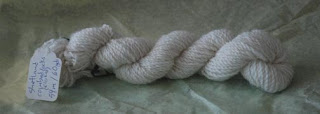
Friday, December 18, 2009
Saturday, December 12, 2009
Sunday, November 8, 2009
Flax Processing by Hand
This flax has been retted. It was soaked in a wading pool for three or four weeks. Then dried for another two weeks on a rack in the garage. This meat tenderizer works okay but I'd like to have some more heavy duty tool for breaking up the pith.

 I'm saving the seeds.
I'm saving the seeds.


 A lot of the pith has broken away and I'm pounding it some more.
A lot of the pith has broken away and I'm pounding it some more.

 I'm saving the seeds.
I'm saving the seeds.

 A lot of the pith has broken away and I'm pounding it some more.
A lot of the pith has broken away and I'm pounding it some more.


This is one of the above four bundles that has been combed. I used a wool comb but a flax hackle would be faster.

Sunday, October 18, 2009
Sunday, October 11, 2009
Saturday, October 10, 2009
Monday, September 14, 2009
 Hand spun singles Mohair. Top to bottom: Japanese Indigo 1st vat (3 skeins), Dahlia & Marigold Flowers over final dip Japanese Indigo (2 skeins), Japanese Indigo 3rd vat (1 skein), Japanese Indigo third vat over Dahlia Flowers (1 skein).
Hand spun singles Mohair. Top to bottom: Japanese Indigo 1st vat (3 skeins), Dahlia & Marigold Flowers over final dip Japanese Indigo (2 skeins), Japanese Indigo 3rd vat (1 skein), Japanese Indigo third vat over Dahlia Flowers (1 skein). Recycled yarn from thrift store. Left to right: Japanese Indigo 1st vat, Japanese Indigo 3rd vat, Dahlia Flowers, Peppergrass whole plant, Eucalyptus Leaves.
Recycled yarn from thrift store. Left to right: Japanese Indigo 1st vat, Japanese Indigo 3rd vat, Dahlia Flowers, Peppergrass whole plant, Eucalyptus Leaves. Millspun Merino left to right: Japanese Indigo 1st vat, Dahlia & Marigold Flowers, Dahlia Flowers, Perrergrass whole plant.
Millspun Merino left to right: Japanese Indigo 1st vat, Dahlia & Marigold Flowers, Dahlia Flowers, Perrergrass whole plant.
Saturday, September 5, 2009
Continuing Japanese Indigo Dyeing
 After heating in canning pot to 160˚F and then steeping overnight. It got late so I let it sit overnight.
After heating in canning pot to 160˚F and then steeping overnight. It got late so I let it sit overnight. In the vat. I used washing soda as the alkali and then beat it with an electric mixer for about 5 minutes. Then added color remover as the reducing agent. Now it is waiting for an hour while slowly heating up to 100˚- 120˚F. I also have a small batch in a yogurt maker to try the yeast fermentation method of reduction.
In the vat. I used washing soda as the alkali and then beat it with an electric mixer for about 5 minutes. Then added color remover as the reducing agent. Now it is waiting for an hour while slowly heating up to 100˚- 120˚F. I also have a small batch in a yogurt maker to try the yeast fermentation method of reduction.Friday, September 4, 2009
Japanese Indigo
Wednesday, August 26, 2009
Tuesday, August 25, 2009
First Harvest
Monday, July 6, 2009
Sunday, July 5, 2009
Monday, June 15, 2009
Making the Beds
Tuesday, May 26, 2009
Katahdin -- My first really local fleece
Washed Shetland
Subscribe to:
Posts (Atom)






































